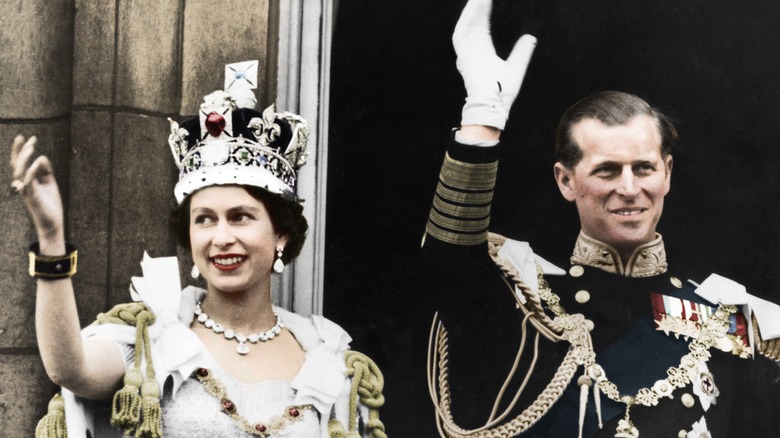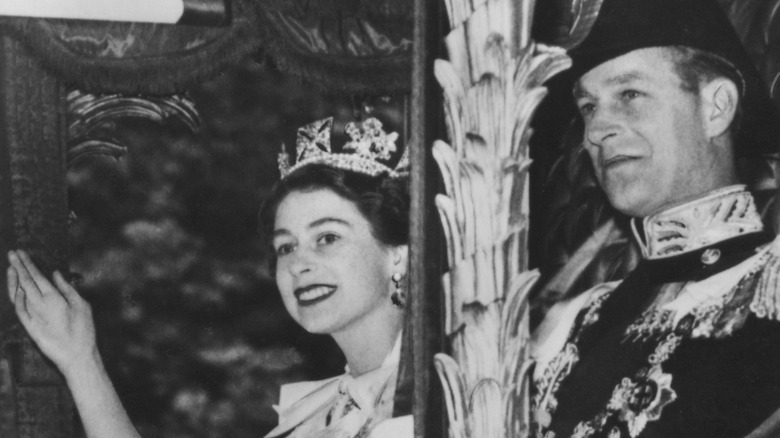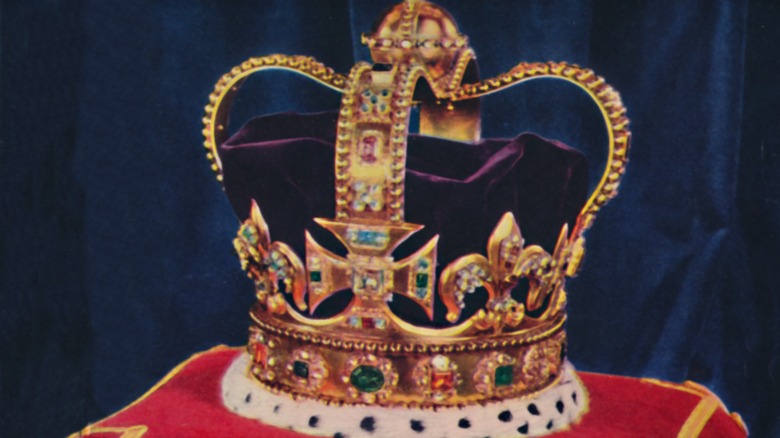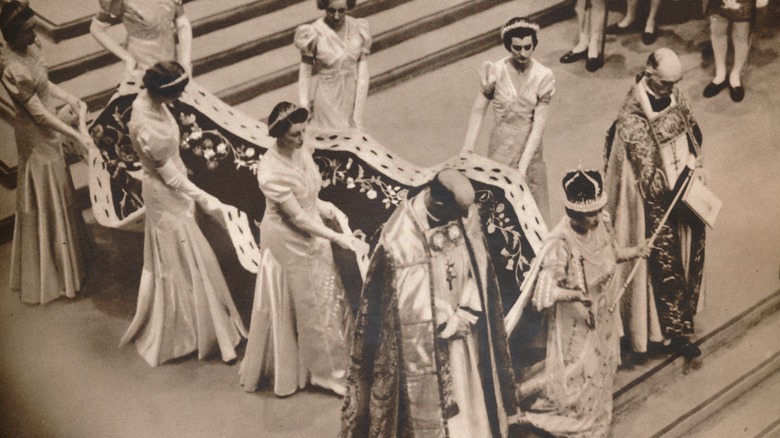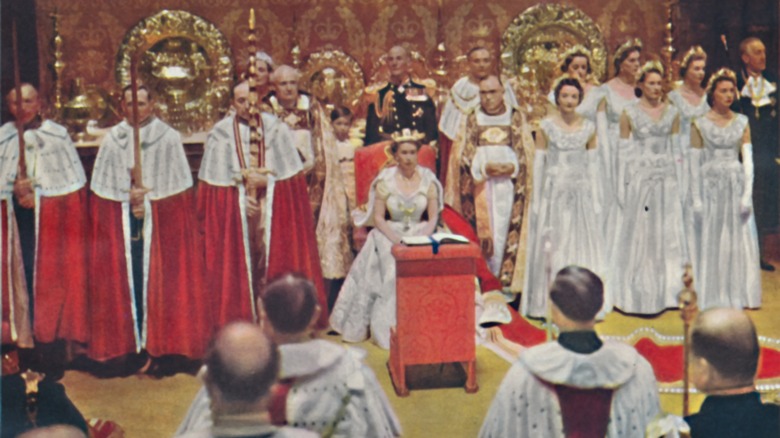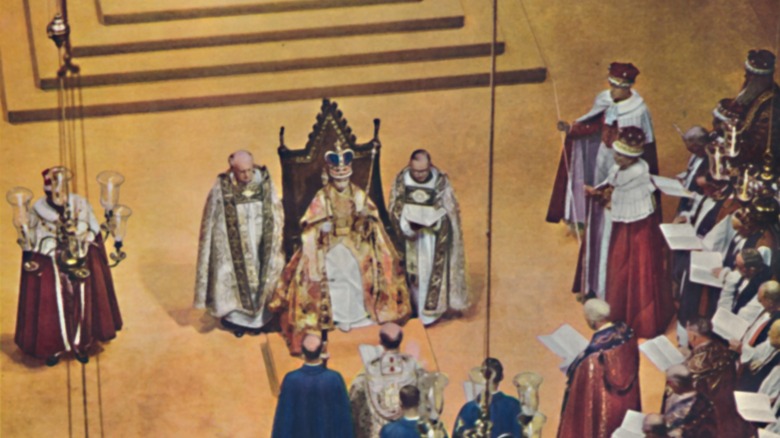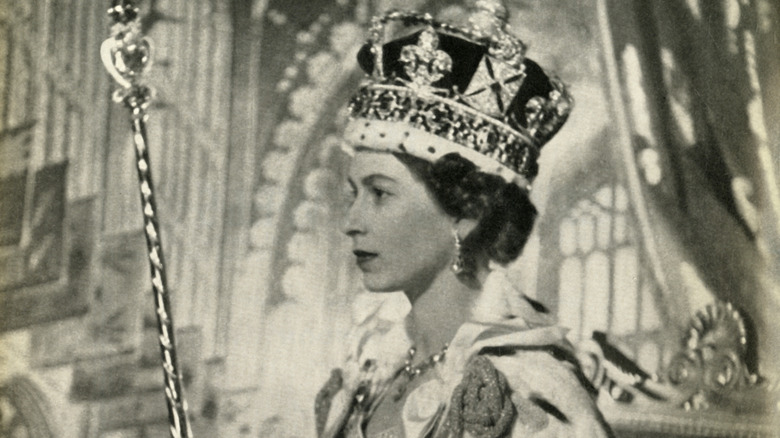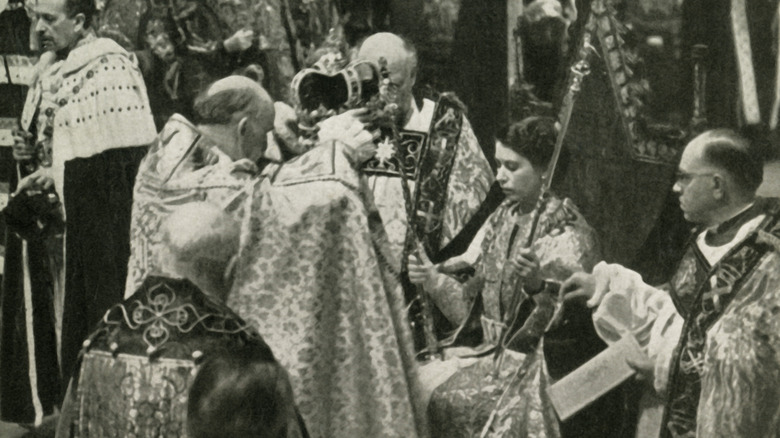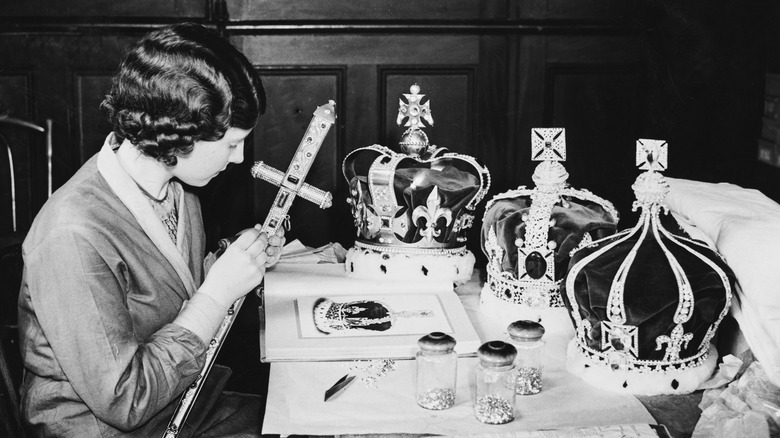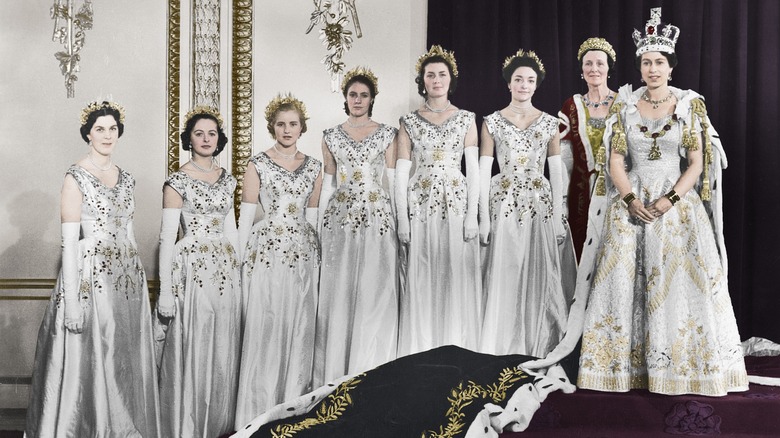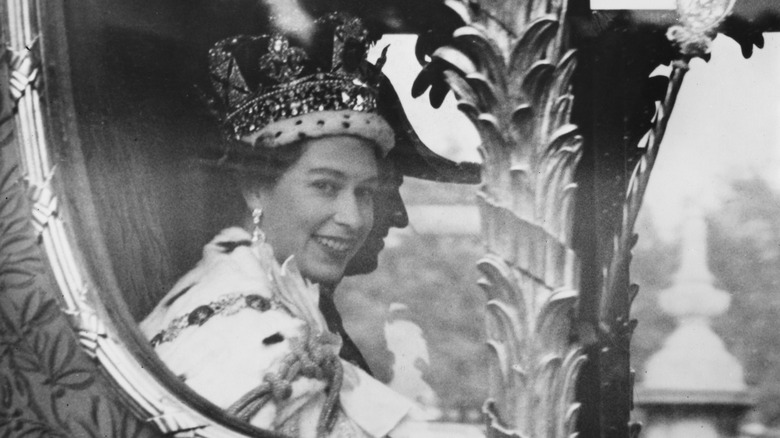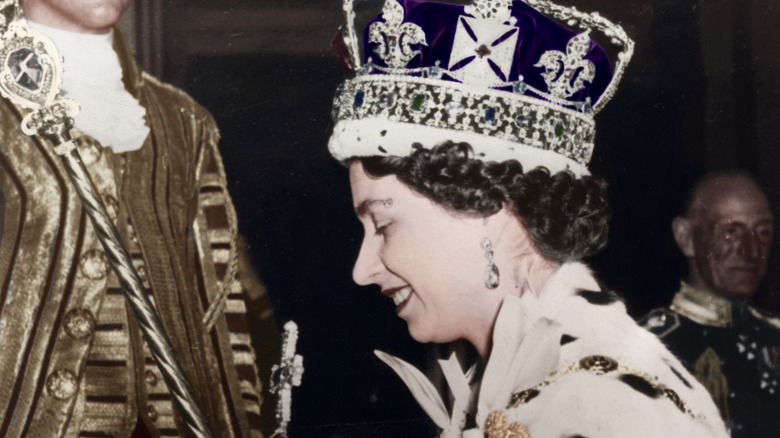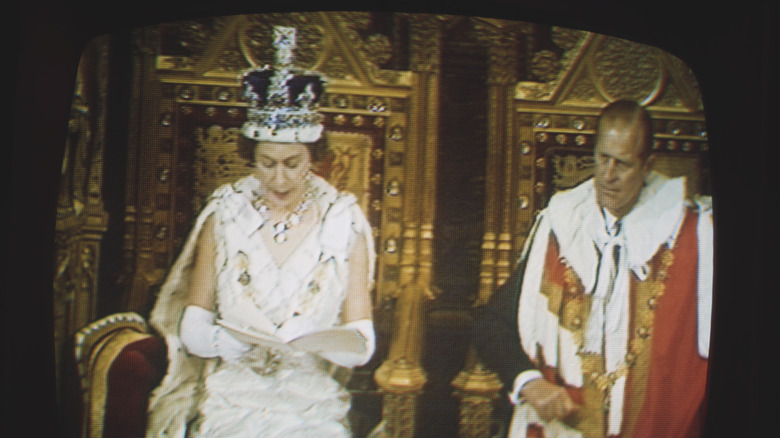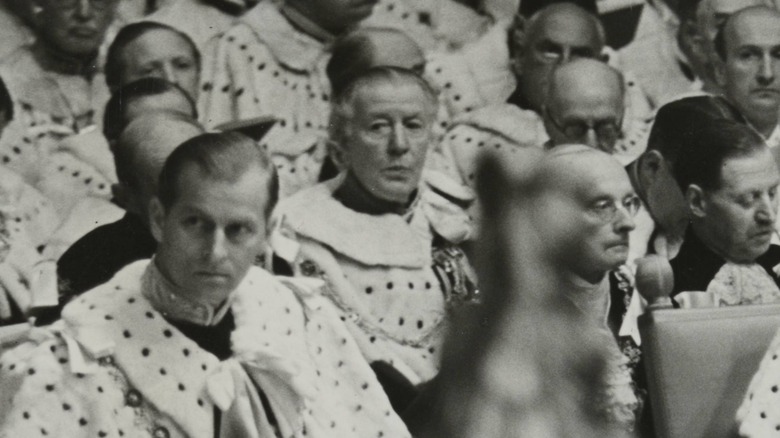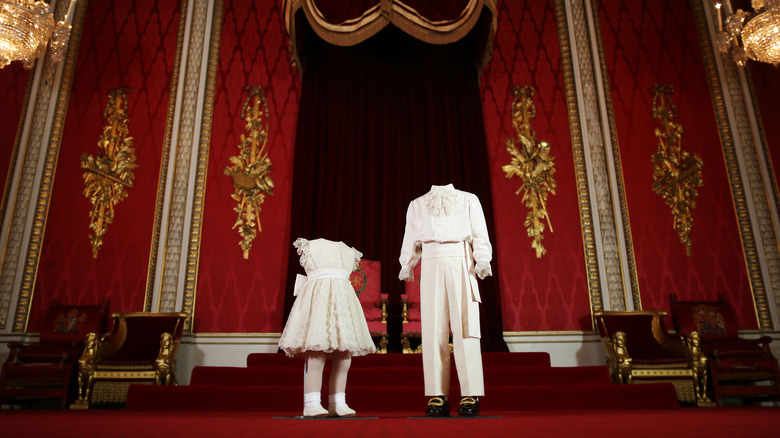The Most Memorable Moments From Queen Elizabeth's Coronation
On June 2, 1953, Queen Elizabeth II was crowned queen of England. On this momentous occasion, Elizabeth underwent the same ceremonial processes as many of her ancestors. Indeed, the queen more than likely recalled the 1937 coronation of her own parents, who famously took the throne after her uncle, King Edward VIII, abdicated to marry the American divorcée, Wallis Simpson.
At the time, Elizabeth was just 11 years old, although the letter of congratulations that she wrote her parents following the ceremony indicates that she found their ascension magical. As the heir told her parents, "I thought it all very, very wonderful, and I expect the Abbey did, too. The arches and the beams at the top were covered with a sort of haze of wonder as Papa was crowned, at least I thought so" (via Royal Collection Trust). Even so, the young Elizabeth also recalled the more human aspects of the ceremony: the "most awful draught" that had everyone cold in the Abbey, the "sandwiches" and "stuffed rolls" she ate before the procession through London, and even the family photos taken "in front of those awful lights."
On the day of Elizabeth's own coronation, one has to wonder how often she thought back to the last ceremony she had attended. Like her parents' coronation, the new queen's was magical, photographed, and perhaps even a bit drafty. From Elizabeth's arrival at Westminster Abbey to the young Prince Charles' reaction to his mother, the event was deeply memorable.
Queen Elizabeth's arrival at Westminster Abbey
During Queen Elizabeth II's own childhood, she recalled watching people line up for her parents' coronation well before daybreak. In the congratulatory letter that she wrote to her parents following the ceremony, the young Elizabeth wrote: "At 5 o'clock in the morning I was woken up by the band of the Royal Marines ... We crouched in the window, looking onto a cold, misty morning. There were already some people in the stands" (via Royal Collection Trust).
Years later, at her own coronation, history was bound to repeat itself. After all, public interest in the monarchy remained sky-high. Per a 1977 edition of The New Yorker, about half a million people spent several evenings camping outside, desperate to guarantee that the newly-crowned Queen Elizabeth would be within eyeshot during her procession. A wealthier crew paid a hundred pounds for balcony seats with a bird's-eye view.
Thus, one of the most exciting moments of Elizabeth's coronation ceremony was the moment that she arrived at Westminster Abbey in the magnificent Gold State Coach. As seen in the BBC's footage of the event, Elizabeth stepped out of the historic carriage and was immediately met with the roar of the crowds (via YouTube). The viewers screamed and bellowed as she passed, raising their voices even higher whenever they caught a glimpse of her.
The procession with the crown jewels
One of the most beautiful moments from the tradition of British coronations is almost certainly the arrival of the crown jewels. During Queen Elizabeth II's coronation ceremony, the crown jewels arrived moments before the monarch herself emerged from the back rooms. Borne in the arms of the royal jeweler, then Garrard & Co., these magnificent items likely made quite an impression on the audience of international leaders that had been invited to attend the ceremony. As expressed by commentator Richard Dimbleby in the BBC coverage of the event, "For many of the representatives of countries of the world gathered now at each side, this will be the first moment during which they have been able to see some of the priceless and wonderful regalia of our land" (via YouTube).
In their totality, the crown jewels consist of over one hundred items. However, on the date of Elizabeth's coronation, Garrard only carried in a dozen key objects, including the Sovereign's Ring, the jeweled sword, and a pair of armills, or royal armlets. Interestingly, the armills are supposed to represent the military values of sincerity and wisdom. A new pair was created specifically for Elizabeth in order to replace the last ones, which had been in use since 1661 (per Royal Collection Trust).
When Queen Elizabeth sat down for the first time
Although every queen must have a throne, Queen Elizabeth II hardly spent her coronation ceremony perched in one of these royal seats. On the contrary, the new queen spent much of the event seated on the Coronation Chair, which has been in use ever since King Edward I commissioned it 700 years ago. She also sat in a normal prayer seat, located far from the center stage.
Toward the beginning of Elizabeth's coronation, when she sat in this simple prayer chair, the moment was absolutely riveting. Donning the Robe of State, Elizabeth was followed by a long train that required the assistance of six maids of honor to manage. Although the people who watched the televised version of the coronation wouldn't have noticed the robe's vibrant red, ermine-lined fabric, it would have been impossible to ignore the amount of attention required to pull the robe aside so that the queen could say a prayer and take her chair. As shown in the BBC broadcast of the event, Elizabeth's robe needed to be adjusted several times both before and after she took her seat (via YouTube).
When Queen Elizabeth curtsied
Queen Elizabeth II was not known for curtsying to anyone. However, during her reign, it was considered appropriate for everyone — even members of her own family — to greet her with either a bow or a curtsy. Even so, the queen was known to bow her head on occasion as a way to show her deference to an individual or an institution. In 1997, she was photographed lowering her head at the funeral of Diana, Princess of Wales. At her coronation, meanwhile, Elizabeth was filmed doing a slight curtsy, perhaps as a way to show reverence to the religious and cultural ceremony at hand.
This unusual move took place during the part of her coronation when Archbishop Geoffrey Francis Fisher presented Elizabeth to each corner of her kingdom. "Sirs," the archbishop began repeatedly, as he faced the east, south, west, and north, respectively, "I here present unto you Queen Elizabeth, your undoubted queen. Wherefore all you who are come this day to do your homage and service, are you willing to do the same?" In response, the people from each side of the abbey replied, "God save Queen Elizabeth." To this reply, the BBC footage reveals, Elizabeth responded with a rare curtsy (via YouTube).
When she gave her coronation oath
In a lot of ways, a coronation ceremony is a lot like a wedding in which the monarch and her people pledge a public commitment to one another. At Queen Elizabeth II's coronation, this was evident in the vows she took. The queen's oath was both legal and religious, although it began with the promise that she would rule all of the territories of the British Empire, "according to their respective laws and customs" (via Oremus). Elizabeth went on to swear that her judgments would "cause law and justice, in mercy."
Compellingly, the queen's oaths included many references to Christianity, as her coronation also marked her new role as the head of the Church of England. During the ceremony, Archbishop Geoffrey Francis Fisher asked Elizabeth, "Will you to the utmost of your power maintain the Laws of God and the true profession of the Gospel?" He also made several other religious inquiries, including: "Will you to the utmost of your power maintain in the United Kingdom the Protestant Reformed Religion established by law?" To these questions, Elizabeth solemnly replied, "All this I promise to do."
When she kissed the Bible
Although the coronation of a British monarch is intrinsically related to the Church of England, not all the royals crowned before Queen Elizabeth II were serious about the ceremony's religious component. According to a 1977 piece in The New Yorker, Elizabeth's uncle King Edward VIII asked in 1936 "whether it was possible to have the coronation ceremony without a Communion service; he was told they were one and the same." The same article went on to report, "The queen doesn't need this sort of reminder."
Indeed, throughout Elizabeth's coronation, the queen seemed to take her religious role seriously. BBC footage of the event shows that, as the final part of her oath, Elizabeth swore, "The things which I have here before promised, I will perform, and keep. So help me God" (via YouTube). The new queen then proceeded to kiss the Bible as a show of good faith and signed her oath.
Interestingly, the transcript of her coronation reveals that Elizabeth likely said this oath while placing her right hand on the Bible, placing the holy text at the center of the ceremony (via Oremus).
Queen Elizabeth's oil anointment ceremony
Easily one of the most intense moments of Queen Elizabeth II's coronation, the oil anointment ceremony occurred when Archbishop Geoffrey Francis Fisher applied holy oil to the monarch's hand, breast, and head. As revealed by the BBC's archives from the event, Elizabeth's oil anointment began when the Robe of State was removed from her body (via YouTube). She also shed her jewels and her tiara. Next, the queen was given a simple white ceremonial garment, known as the Colobium Sindonis. It was wearing this humble attire that Elizabeth was anointed at the hands of the archbishop.
Fascinatingly, the anointment ceremony has long been considered a private affair, meaning that the application of oil to the monarch cannot be viewed by an audience. As explained by the BBC in 1953, "Four Knights of the Garter ... bring forward a golden canopy, which they hold over Her Majesty so that the sacred moment of anointing, normally never seen, is shielded from all eyes" (via YouTube). Consequently, the TV cameras present at the event turned away, showing only a tapestry, while the queen underwent this ceremony.
It is said that Elizabeth was anointed with a blend of olive oil and sesame oil, which was then treated to have an agreeable, perfume-like scent, according to Perfume Society.
The 600-year-old sword ceremony
One of the longest-lasting traditions at British coronation ceremonies is known as the Sword of Offering (per Royal Collection Trust). By the time Queen Elizabeth II was crowned queen in 1953, this ceremony was said to have been around for approximately six centuries. In this ritual, the bearer of the jeweled sword must hand it over to he who holds the title of Lord Chamberlain. This recipient then passes the sword off to the Archbishop of Canterbury, who places it on the altar and blesses it.
Interestingly, however, once the archbishop finally hands the sword to the monarch, it doesn't stay in her hands for long. During Elizabeth's coronation ceremony, the queen walked the sword to the altar, leaving it in the hands of the archbishop. According to the BBC broadcast of the event, "The queen offers the sword upon the altar. She gives it in the service of God" (via YouTube).
Her faithful men, though, do not allow the jeweled sword to sit on the altar forever. The original bearer of the object, in this case, Lord Salisbury, stepped forward and exchanged the sword for a bag of coins. In the words of the BBC footage, the lord then proceeded to "carry it before the queen for the rest of the service."
The presentation of the Pallium Regale
For British monarchs, coronation day can mean plenty of costume changes. During her coronation, Queen Elizabeth II changed robes and garments on various occasions — not least exciting when she donned the Robe Royal, or the Pallium Regale. This unique garment is only worn when the monarch receives the crown for the first time. Embroidered with silver eagles, this robe carries deep symbolism for the future king or queen. It is said to be a reminder of the holy responsibilities involved in wearing the crown.
The moment when Elizabeth wore this robe for the first time was absolutely spectacular. However, she was not expected to put it on herself. As explained in the BBC footage of the event, "The Dean of Westminster and the Mistress of the Robes put the heavy pall upon the queen. The Lord Great Chamberlain will fasten the cusps" (via YouTube). Fascinatingly, this specific robe was one of the few garments that had not been custom-made for Elizabeth preceding the ceremony. The Robe Royal had been in use since King George IV took the throne in 1821.
When she accepted the 'wedding ring of England'
Royal robes were not the only symbolic clothing that Queen Elizabeth II wore at her 1953 coronation. The monarch also wore symbolic jewelry, including the Sovereign's Ring. Made in 1831, this gorgeous ring is comprised of a large sapphire, meant to invoke the Scottish flag, surrounded by diamonds. Through the center of the ring run baguette-cut rubies that resemble a cross. The cross is meant to call to mind the cross of St. George — a symbol of England.
As revealed by the BBC footage of Elizabeth's coronation, the queen looked quite solemn when she received this important piece of regalia. Given the symbolism of the object, however, this reaction was to be expected. In the words of the BBC presenter, "This is often called the wedding ring of England" (via YouTube). As if in parallel to the wedding ring that one would normally wear on the fourth finger of their left hand, Elizabeth wore this ring on the fourth finger of her right one.
The moment the crown touched her head
In some ways, the climax of the coronation ceremony is the moment that the monarch is officially — well, coronated. When the Archbishop of Canterbury finally placed the crown on Queen Elizabeth II's head, she was essentially able to ascend to the throne.
As shown by the BBC recordings of Elizabeth's coronation, this moment was spectacular (via YouTube). Taking the historic St. Edward's crown into his hands, the archbishop brought the nearly 300-year-old item toward Elizabeth, before raising it high into the air. Carefully, he lowered the crown onto her forehead.
In the spirit of the crown's history, Elizabeth showed no emotion during this important moment. Instead, she wore St. Edward's crown with stoicism — even understanding that this would be the last time she would ever wear it. Indeed, British monarchs only wear this piece of regalia on their coronation day. The crown itself is made of gold and decorated with rubies, sapphires, amethysts, and other precious jewels.
When Queen Elizabeth sat on her throne
Throughout most of her coronation ceremony, Queen Elizabeth II alternated between a simple prayer seat and the official royal Coronation Chair. However, it wasn't until the end of the service that the queen was finally permitted to sit on her throne. The BBC footage of the event captured Elizabeth as she walked from the Coronation Chair to the throne (via YouTube). Wearing the St. Edward's crown on her head and holding the scepter and orb in her hands, the queen slowly made her way to her final seat of the service.
This time, when it came to making her way across the abbey, Elizabeth did not receive the help of her maids of honor. Instead, she walked to her throne with the Archbishop of Canterbury on one arm and the Earl Marshal on the other. The moment that she sat down was extremely memorable. As the BBC coverage explained, "It is at the moment that she is seated upon her throne that she takes possession of her kingdom."
When Prince Philip presented himself to the queen
Queen Elizabeth II's husband, Prince Philip, was never meant to become king. Although he was a direct descendant of Queen Victoria, Philip simply did not have the magical combination of blood tie and birth order that paved the way for Elizabeth's ascension. However, he was allowed to play a significant role in his wife's coronation. The BBC broadcasting of the event shows that Philip, as the Duke of Edinburgh, was the first person permitted to pledge his allegiance to the queen after she took her throne (via YouTube).
Transcripts from the event show that Philip expressed his homage through a vow: "I, Philip, do become your liege man of life and limb and of earthly worship; and faith and truth I will bear unto you, to live and die, against all manner of folks. So help me God" (via Oremus). He then proceeded to give Elizabeth a gentle kiss on the cheek.
Seeing King Charles watch his mother become queen
Inevitably, the coronation of Queen Elizabeth II was a momentous moment for her oldest son, who was then known as Prince Charles. At the tender age of 4 years old, Charles likely watched his mother's coronation with the same level of rapture that Elizabeth once watched her own parents ascend to the throne. In the BBC special, we can see Charles sitting beside his maternal grandmother (via YouTube). Captivated by the scene, the young prince was filmed leaning so far forward that he was practically out of his seat.
Anne Tennant, Baroness Glenconner, one of Elizabeth's six maids of honor, recalled the prince's fascination with the coronation in an interview with People. According to this royal insider, the future king was very curious about everything he saw. Tennant explained, Charles "was [seated] just above me. He was brought in for the crowning. We were standing below him, and he was up there with Queen Elizabeth, the queen mother. I could hear him talking, asking her what was what."
